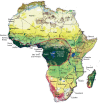Loa loa infection detection using biomarkers: current perspectives
- PMID: 30050354
- PMCID: PMC6047611
- DOI: 10.2147/RRTM.S132380
Loa loa infection detection using biomarkers: current perspectives
Abstract
Loa loa is originally a restricted filarial worm from central Africa and some west African countries. However, numerous imported cases are being reported throughout the world due to human movement. Traditionally, its diagnosis is based on identification of microfilariae in the peripheral blood or the passage of the adult worm under the conjunctiva. However, few patients have microfilariae in their peripheral blood, while the majority of infected people are amicrofilaremic (without microfilariae in their blood), despite clinical symptoms suggesting L. loa infection. This situation suggests that diagnoses based on the presence of microfilariae in the blood or the ocular passage of an adult worm, are not sensitive. Therefore, it seems necessary to search for biomarkers to remedy this situation. Furthermore, L. loa is a major obstacle in the control of other filarial worms in areas where these filariae are co-endemic. To develop a diagnostic tool based on a biomarker, several approaches have been considered using antibodies, antigens or nucleic acid detection. However, none of the diagnostic techniques in loiasis based on biomarkers has reached the point of care as have microscopic detection of microfilariae or observation of ocular passage of a worm.
Keywords: DNA; Loa loa; antibody; antigen; diagnosis.
Conflict of interest statement
Disclosure The authors report no conflicts of interest in this work.
Figures


References
-
- Antinori S, Schifanella L, Million M, et al. Imported Loa loa filariasis: three cases and a review of cases reported in non-endemic countries in the past 25 years. Int J Infect Dis. 2012;16(9):e649–662. - PubMed
-
- Ushirogawa H, Okino T, Hatsushika R, Tabuchi A. Morphological studies of the adult female Loa loa (Nematoda: Filarioidea) and a review of the literature on imported human loiasis in Japan. Kawasaki Med J. 2003;29(3–4):53–59.
-
- Yoshikawa M, Ouji Y, Hayashi N, et al. Diagnostic problems in a patient with amicrofilaremic Loa loa. J Travel Med. 2008;15(1):53–57. - PubMed
-
- Klion AD, Massougbodji A, Sadeler BC, et al. Loiasis in endemic and nonendemic populations: immunologically mediated differences in clinical presentation. J Infect Dis. 1991;163(6):1318–1325. - PubMed
-
- Nutman TB, Miller KD, Mulligan M, Ottesen EA. Loa loa infection in temporary residents of endemic regions: recognition of a hyperrespon-sive syndrome with characteristic clinical manifestations. J Infect Dis. 1986;154(1):10–18. - PubMed
Publication types
LinkOut - more resources
Full Text Sources
Other Literature Sources

